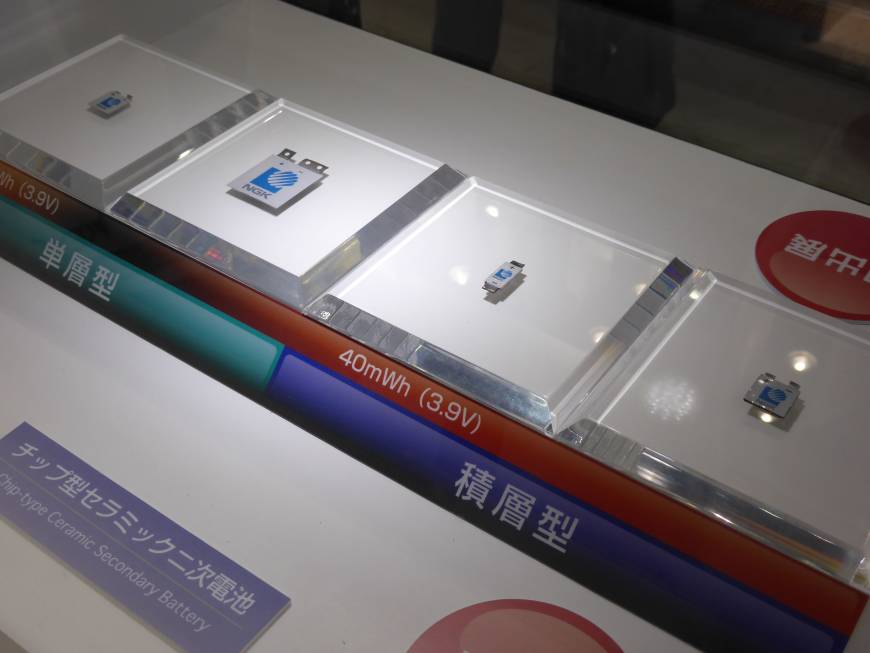Source: japantimes.co.jp
Published: May 8, 2016

This Hitachi Zosen solid-state battery (center) powers a laser displacement meter (right) while another meter (left) measures its output. courtesy of hitachi zosen Corp. | COURTESY OF HITACHI ZOSEN CORP
By Shusuke Murai
In an increasingly digital society, acquiring power to keep our smartphones, laptop computers and electric vehicles running is becoming essential to stay in communication and to get around.
To make gadgets and appliances last longer as well as run smaller, thinner devices, Japanese manufacturers are working on what they think is a next-generation power source: solid-state rechargeable batteries.
In 2010, the New Energy and Industrial Technology Development Organization, a government-funded research body dubbed NEDO, urged manufacturers to develop innovative rechargeable batteries by 2030.
Today’s lithium-ion batteries are based on electrolytes — liquid chemicals that mediate the flow of electrons between the positive and negative electrodes of a battery.
The new solid-state batteries currently under development make use of ionic-conducting materials in addition to electrolytes, giving them more power capacity in a less bulky body, said Kazuyuki Sunayama of industrial machinery maker Hitachi Zosen Corp.
Given the same volume, Hitachi Zosen’s solid-state batteries will provide about 1.5 times the capacity of current lithium-ion batteries, meaning they can last longer or provide the same amount of power in a smaller form, Sunayama said.
Another advantage of the solid-state battery is high resistance to extreme temperatures.
Compared with liquid-state lithium-ion batteries, which work in temperatures between minus 20 and 60 degrees, the solid-state version can operate between minus 40 and 100.
That means solid-state batteries can be used for special applications, including operations in outer space and in sensors at incineration plants, Sunayama said.
The high temperature resistance also makes solid-state batteries safer because their liquid-state counterparts generate flammable gas when exposed to high temperatures, presenting the now-common risk of fire or explosion.
This is less true of the new solid-state batteries, he explained.
“You may have seen lithium-ion batteries in mobile devices swell when left in a car. That would no longer happen,” he said.
These solid-state lithium-ion batteries also have longer life cycles than conventional lithium-ion batteries, which can experience a drop in capacity to 80 percent after 500 charge and discharge cycles in an iPhone.
Hitachi Zosen aims to deliver a solid-state version that retains up to 90 percent of its capacity after 7,000 cycles — about 20 years’ worth of daily use — Sunayama said.
This means it will be a plus for the environment as well, Sunayama said.
“In the case of electric vehicles, the car itself might have to be replaced after 20 years, but the car’s battery can be reused for other purposes,” he said.
Hitachi Zosen aims to start mass-producing solid-state batteries for special uses by 2020. It plans to adapt them to electric vehicles by around 2025.
But there are still many hurdles to clear.
Compared with today’s lithium-ion batteries, Hitachi Zosen’s new ones cannot deliver large amounts of power at once, which means their use in EVs is far off, Sunayama said.
Also, because it uses sulfide-based materials, which can produce toxic gas when exposed to hydrogen in the atmosphere, safer configurations are required for daily use.
Although originally a ship maker before focusing on engineering, Hitachi Zosen entered the battery field about 10 years ago to make use of its technology for compressing powders.
“There are many kinds of all-solid-state batteries and each uses various materials. Each manufacturer has its own strength, and that determines what kind of battery is produced,” Sunayama explained.
Other manufacturers of solid-state batteries include Nagoya-based NGK Insulators Ltd., which demonstrated a small, ceramic-based rechargeable battery in Tokyo in April that is just 0.2 mm thick — a product of its ceramics technology.
NGK Insulators said that it is looking to power smaller devices, such as IC chip-equipped smart cards, wearable devices and IoT (Internet of Things) devices, said company spokeswoman Aki Sawafuji.
“As electronic products become smaller, we believe our battery could be used for those devices,” Sawafuji said, adding the company aims to have a battery for practical use in play by 2017.
Still, there remains room for more competition in the field because there are more materials to work with compared with conventional batteries, Sunayama of Hitachi Zosen said.
“We want the development of all-solid-state batteries to become energized,” Sawafuji said.
